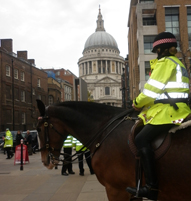Should guard forces get out of cars and onto horses?! The Professional Security articles on Project Servator in Glasgow before the Commonwealth Games in the summer and in the City of London, as pictured, and featured in the December 2014 print issue of the magazine, found people still take an interest in the police horse.
Researchers have measured the value of mounted police units in the UK. They found that the high visibility of the police horses and riders on neighbourhood patrols boosts public confidence in the police. In trials, the researchers from the University of Oxford and RAND Europe observed that mounted police units generated around six times more public interest than foot patrols over the same period, although most of these interactions were brief (the number of longer conversations was similar for both mounted police and foot patrols).
At the Glastonbury Festival in June 2014, the researchers also observed over three times more interactions between festival-goers and mounted police than with officers on foot, with most of these interactions being positive. The report highlights that mounted units also play a role at crowd events where disorder is likely. It says they appear to be able to intervene when other resources, such as police on foot or in vehicles, would be ineffective or even risk aggravating the situation. Mounted police at football matches were found to have a small, but statistically significant effect on disorder. However, the report is cautious about overestimating the need for mounted police at all crowd events, saying it is difficult to attribute successful outcomes solely to the presence of mounted units.
Over half of the residents questioned at one trial site in Gloucestershire, interviewed after the patrols had taken place, said they had noticed mounted units in their area. This was the highest proportion of respondents to report they had noticed mounted units in their neighbourhood.
During an 18-month study, the researchers assessed the impact of mounted units in different roles. The researchers examined public reactions to mounted units on neighbourhood patrols, a music festival, at football matches and public demonstrations. Neighbourhood patrols by pairs of mounted police officers were trialled in three areas in Gloucestershire and London in March 2014. Interviews with police at the start of the project suggested that mounted units were broadly viewed as a resource for crowd control. However, the new research suggests that mounted units have value in other scenarios too, particularly in neighbourhood policing. Mounted units were found to help build positive relationships with the public, acting as an “ice-breaker” for encouraging greater interaction between police officers and public.
Public surveys also tested whether the mounted unit patrols had an effect on public trust and confidence in the police. The researchers found that the use of mounted patrols had a bolstering effect on trust and confidence in the trial sites, when compared to opinion in three control sites that did not receive mounted patrols. The size of this effect amounted to a greater than 10 percentage point shift in opinion, on some measures.
Study co-author Dr Ben Bradford, from the Centre for Criminology at the University of Oxford, said: ‘In community settings, the horse and rider combination appears to act as a sort of ambassador and “ice-breaker” for the police. People come up to say “hello” or to make a fuss of the horse before having a quick conversation with the officer. Although most of the exchanges we saw were brief, they tended to be very friendly, and the patrols increased police visibility. Many people react positively to greater police visibility in their neighbourhood, and we believe this translated into higher levels of trust and confidence in the areas where the mounted patrols took place.’
Study co-author Dr Chris Giacomantonio, a researcher with RAND Europe and the University of Oxford, said: ‘We have shown for the first time how the value of mounted units can be systematically measured and demonstrated. From what we’ve found, it seems clear that they have a substantial value at neighbourhood level and police forces across the UK are increasingly recognising this.’
The study notes that the number of mounted sections across England, Scotland and Wales has fallen from 17 in 2012 to 12 in 2014, raising a number of questions about both local and national policing capacity. The report stresses that it does not set out to recommend to forces how they spend their budgets or whether they should have mounted units. Instead, it provides systematic evidence on the ‘demonstrable and measurable impact of mounted police units’ in different scenarios.
From ACPO, the national lead for mounted policing, Deputy Chief Constable Rod Hansen, said: ‘This provides the police with new evidence suggesting that mounted units still have great utility in modern policing, particularly in neighbourhoods. In the light of this, despite the financial limitations, we must ensure that we do not inadvertently lose a capability that offers so much to policing services without fully understanding the consequences.’









